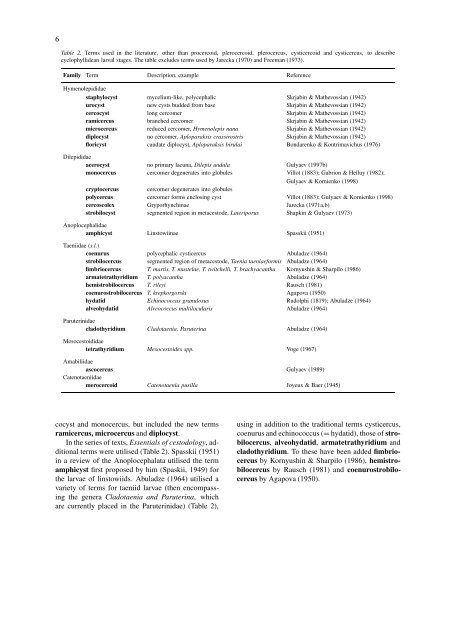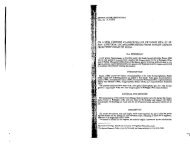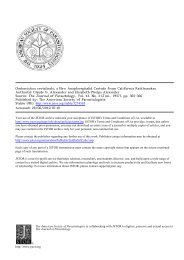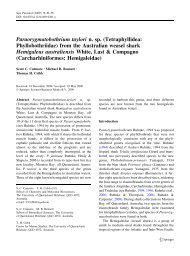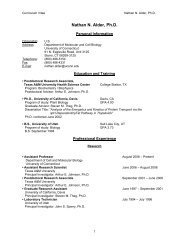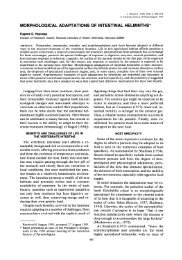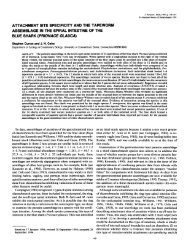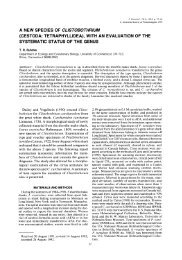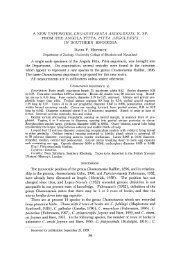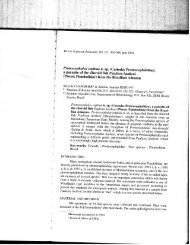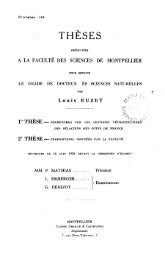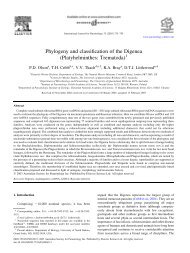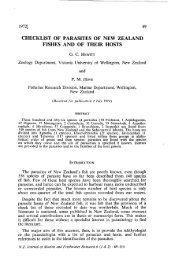The terminology of larval cestodes or metacestodes
The terminology of larval cestodes or metacestodes
The terminology of larval cestodes or metacestodes
Create successful ePaper yourself
Turn your PDF publications into a flip-book with our unique Google optimized e-Paper software.
6Table 2. Terms used in the literature, other than procercoid, plerocercoid, plerocercus, cysticercoid and cysticercus, to describecyclophyllidean <strong>larval</strong> stages. <strong>The</strong> table excludes terms used by Jarecka (1970) and Freeman (1973).Family Term Description, example ReferenceHymenolepididaestaphylocyst mycelium-like, polycephalic Skrjabin & Mathevossian (1942)urocyst new cysts budded from base Skrjabin & Mathevossian (1942)cercocyst long cercomer Skrjabin & Mathevossian (1942)ramicercus branched cercomer Skrjabin & Mathevossian (1942)microcercus reduced cercomer, Hymenolepis nana Skrjabin & Mathevossian (1942)diplocyst no cercomer, Aploparaksis crassirostris Skrjabin & Mathevossian (1942)fl<strong>or</strong>icyst caudate diplocyst, Aploparaksis birulai Bondarenko & Kontrimavichus (1976)Dilepididaeacerocyst no primary lacuna, Dilepis undula Gulyaev (1997b)monocercus cercomer degenerates into globules Villot (1883); Gabrion & Helluy (1982);Gulyaev & K<strong>or</strong>nienko (1998)cryptocercus cercomer degenerates into globulespolycercus cercomer f<strong>or</strong>ms enclosing cyst Villot (1883); Gulyaev & K<strong>or</strong>nienko (1998)cercoscolex Gryp<strong>or</strong>hynchinae Jarecka (1971a,b)strobilocyst segmented region in metacestode, Laterip<strong>or</strong>us Shapkin & Gulyaev (1973)Anoplocephalidaeamphicyst Linstowiinae Spasskii (1951)Taeniidae (s.l.)coenurus polycephalic cysticercus Abuladze (1964)strobilocercus segmented region <strong>of</strong> metacestode, Taenia taeniaef<strong>or</strong>mis Abuladze (1964)fimbriocercus T. martis, T. mustelae, T. twitchelli, T. brachyacantha K<strong>or</strong>nyushin & Sharpilo (1986)armatetrathyridium T. polyacantha Abuladze (1964)hemistrobilocercus T. rileyi Rausch (1981)coenurostrobilocercus T. krepk<strong>or</strong>g<strong>or</strong>ski Agapova (1950)hydatid Echinococcus granulosus Rudolphi (1819); Abuladze (1964)alveohydatid Alveococcus multilocularis Abuladze (1964)Paruterinidaecladothyridium Cladotaenia, Paruterina Abuladze (1964)Mesocestoididaetetrathyridium Mesocestoides spp. Voge (1967)Amabiliidaeascocercus Gulyaev (1989)Catenotaeniidaemerocercoid Catenotaenia pusilla Joyeux & Baer (1945)cocyst and monocercus, but included the new termsramicercus, microcercus and diplocyst.In the series <strong>of</strong> texts, Essentials <strong>of</strong> cestodology, additionalterms were utilised (Table 2). Spasskii (1951)in a review <strong>of</strong> the Anoplocephalata utilised the termamphicyst first proposed by him (Spaskii, 1949) f<strong>or</strong>the larvae <strong>of</strong> linstowiids. Abuladze (1964) utilised avariety <strong>of</strong> terms f<strong>or</strong> taeniid larvae (then encompassingthe genera Cladotaenia and Paruterina, whichare currently placed in the Paruterinidae) (Table 2),using in addition to the traditional terms cysticercus,coenurus and echinococcus (= hydatid), those <strong>of</strong> strobilocercus,alveohydatid, armatetrathyridium andcladothyridium. To these have been added fimbriocercusby K<strong>or</strong>nyushin & Sharpilo (1986), hemistrobilocercusby Rausch (1981) and coenurostrobilocercusby Agapova (1950).


